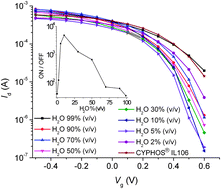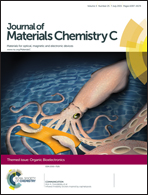Ionic liquid–water mixtures and ion gels as electrolytes for organic electrochemical transistors†
Abstract
Organic Electrochemical Transistors (OECTs) are widely investigated for applications in bioelectronics. Ionic liquids (ILs) are, in principle, interesting candidates as gating media in OECTs. Nevertheless, ILs can exhibit excessively high viscosity that prevents their straightforward application in OECTs. Here we report two processing approaches to apply the highly viscous ionic liquid triisobutyl(methyl)phosphonium tosylate (Cyphos® IL 106) in OECTs based on poly(3,4-ethylenedioxythiophene) polystyrenesulfonate (PEDOT:PSS), namely IL–H2O binary mixtures and ion gels. The use of Cyphos® IL 106–H2O binary mixtures and ion gels as gating media determines an increase of the OECT modulation, with respect to the pure ionic liquid. This increase cannot be explained simply by the change of the viscosity and ionic conductivity of the ionic liquid–H2O mixtures with the increase of the H2O content. Using high surface area activated carbon gates, ON/OFF ratios as high as 5000 are achieved with Cyphos® IL 106–H2O mixtures at 5 and 10% H2O v/v.

- This article is part of the themed collection: Bioelectronics

 Please wait while we load your content...
Please wait while we load your content...